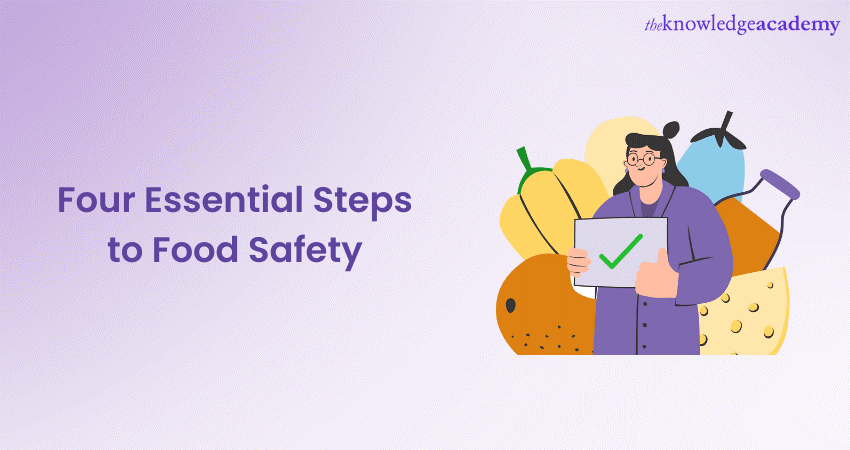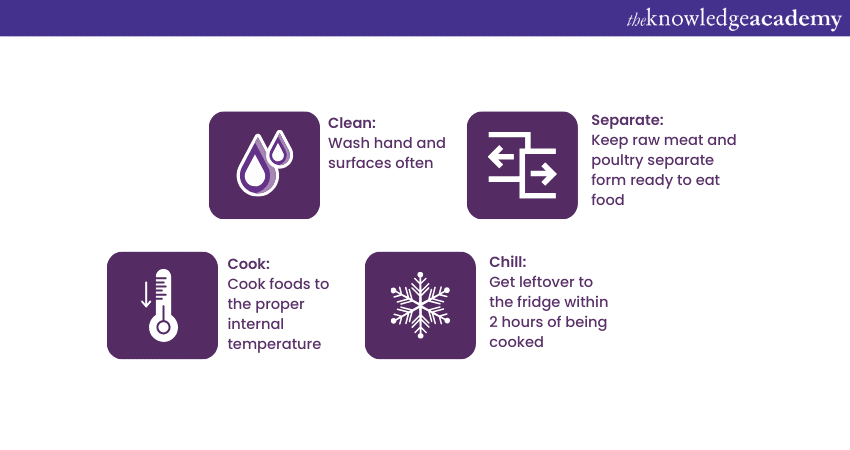We may not have the course you’re looking for. If you enquire or give us a call on 01344203999 and speak to our training experts, we may still be able to help with your training requirements.
Training Outcomes Within Your Budget!
We ensure quality, budget-alignment, and timely delivery by our expert instructors.

In the world of cooking that's always changing, one thing stays the same: how much we need to keep our food safe. It is important to follow the 4 Steps to Food Safety to ensure that you have access to healthy and clean food at your table. So, learn 4 Steps to Food Safety in your kitchen. Protect your health and the well-being of your close ones with these easy-to-follow guidelines. Read further to lern more!
Table of Contents
1) Importance of Food Safety
2) What are the 4 Steps to Food Safety?
a) Step 1- Cleanliness
b) Step 2- Separation technique
c) Step 3- Cooking
d) Step 4- Storage
3) Conclusion
Importance of Food Safety
Ensuring our food is safe to eat is incredibly important. It's not just about enjoying a tasty meal – it's about keeping ourselves and our loved ones healthy. Think about it: if we don't handle, cook, and store our food properly, we could end up with some nasty illnesses. Nobody wants that, right?
Elevate Food Safety standards with Food Hygiene And Safety In Manufacturing Training. Join now!
What are the 4 Steps to Food Safety?
It is important to make sure that the food we eat is not contaminated and is healthy to consume. So, let’s discuss the 4 steps to Food Safety and see how we can keep our food safe:

Step 1- Cleanliness
When it comes to Food Safety, being clean is super important. It's the foundation for making sure the food we eat is safe and yummy. You know the saying "cleanliness is next to godliness"! Well, it really fits here, especially when we're talking about getting our food ready.
Keeping the kitchen clean and making sure we're clean, too, is like setting the scene for making food that's not only tasty but also won't make us sick. It's all about avoiding things that could make us unwell from the food we eat. So, staying clean isn't just good for making meals – it's great for keeping us safe and healthy, too. It involves keeping the following in mind:
a) Hand hygiene: Before you approach any culinary task, take the time to thoroughly wash your hands. Wash it with warm water and soap for at least 20 seconds. Remember to also wash your hands after touching raw foods, using the restroom, and handling waste. This simple yet powerful act can significantly reduce the risk of cross-contamination and foodborne illnesses.
b) Clean surfaces and utensils: The surfaces and utensils in your kitchen play a pivotal role in Food Safety. Cutting boards, countertops, knives, and all other equipment should be maintained in a state of proper cleanliness. Regular disinfection is essential to eliminate any traces of harmful bacteria. It is important to note that different surfaces may require different cleaning techniques.
c) Proper kitchen attire: What you wear in the kitchen can impact the safety of the food you prepare. At the same time, it might seem like a minor detail, but donning clean and appropriate kitchen attire can make a significant difference. Consider wearing an apron to prevent loose clothing from potentially falling into the food.
d) Cross-contamination prevention: A crucial aspect of cleanliness revolves around preventing cross-contamination. Cross-contamination occurs when harmful microorganisms from one food item are transferred to another, leading to the potential for foodborne illnesses. To prevent this, ensure strict separation between raw and cooked foods.
e) Personal hygiene: Beyond the kitchen environment, your personal hygiene also plays a role in maintaining Food Safety. If you're unwell or exhibiting symptoms of illness, avoid preparing food altogether. Sneezing, coughing, or touching your face can introduce germs into the food you're handling, so it's important to minimise these actions while cooking.
Step 2- Separation
Out of the 4 Steps to Food Safety, the principle of separation stands as a primary defence against a common enemy: cross-contamination. Cross-contamination means the transfer of harmful microorganisms from one food item to another, potentially turning a wholesome meal into a health hazard. Here's how to ensure your food remains safe:
a) Raw and cooked foods: One of the fundamental aspects of separation revolves around keeping raw and cooked foods separate. When storing ingredients in the refrigerator, ensure that raw meats, poultry, and seafood are placed on the lower shelves to prevent their juices from dripping onto other items. During preparation, designate separate cutting boards, utensils, and knives for raw and cooked foods. This simple yet effective practice minimises the possibility of the harmful being transferred from raw items to cooked dishes.
b) Storage strategies: Effective storage strategies are instrumental in maintaining separation and preventing cross-contamination. Invest in airtight containers to keep raw ingredients contained and to prevent their juices from seeping into other foods. Place raw meats in a separate section or container to avoid any potential leakage.
c) Ready-to-eat foods: Even within the category of ready-to-eat foods, it's important to practice separation. Keep fruits, vegetables, and other items that will be consumed without further cooking away from raw meats and other potential contaminants. Wash these items thoroughly before consumption to remove any surface bacteria.
d) Utensil and tool separation: The same principle applies to utensils and cooking tools. If you use a knife to cut raw chicken, ensure that it's thoroughly cleaned and sanitised before using it to chop vegetables or prepare other items. This practice extends to stirring spoons, tongs, and any other utensil that meets food during the cooking process.
e) Cooking order: When planning your cooking order, aim to prepare raw items first and leave ready-to-eat items for last. This sequence reduces the chances of contamination. Additionally, avoid placing cooked foods on surfaces that have come into contact with raw ingredients without proper cleaning and sanitising.
Empower your Food Safety skills. Join our Food Allergy Awareness Masterclass today!
Step 3- Cooking
Cooking is not merely the transformation of raw ingredients into dishes; it's also a powerful tool in the step of Food Safety. The application of heat during cooking serves as a weapon against harmful bacteria, viruses, and parasites that may take cover within our food. Here' how you can ensure Food Safety while cooking:
a) Temperature guidelines: When it comes to cooking, temperature matters. Different foods have specific internal temperature guidelines that must be reached to ensure their safety. For instance, poultry should be cooked to an internal temperature of 75°C (165°F), while ground meats need to reach 71°C (160°F).
b) Food thermometers: A food thermometer is a small tool that can significantly impact Food Safety. Insert the thermometer into the thickest part of the food, away from bone or fat, to accurately gauge its internal temperature. This practice is particularly vital for larger cuts of meat, where uneven cooking can pose a risk.
c) Cooking time and resting: Beyond reaching the correct internal temperature, adequate cooking time and resting are crucial steps in the process. Cooking times specified in recipes are often designed to ensure that the entire dish reaches the desired temperature.
d) The Maillard reaction: Cooking is not just about safety; it's also about flavour development. The Maillard reaction, which occurs when proteins and sugars react at high temperatures, is responsible for the browning and development of complex flavours in cooked foods. This reaction not only enhances taste but also contributes to the overall appeal of a dish.
e) Food Safety and cooking techniques: Different cooking techniques also play a role in Food Safety. When using methods like grilling, frying, or roasting, ensure that the food's internal temperature reaches the recommended level. These high-heat methods can effectively eliminate harmful pathogens, but only if the proper temperatures are achieved.
Enhance workplace safety with our Food Safety Masterclass. Sign up now for expert insights!
<H3>Step 4- Storage
Out of the 4 Steps to Food Safety, proper storage techniques are not only essential for preserving the flavour and freshness of your food but also paramount for maintaining its safety. Storage is the final act that completes the preparation of food. The following are the key practices while storing food:
a) Refrigeration: Set your refrigerator's temperature to 4°C (40°F) or below to create an environment that inhibits bacterial growth. Remember that perishable items such as raw meats, poultry, dairy products, and ready-to-eat foods like salads should always be stored in the refrigerator. Keep an eye on expiration dates and consume items within their recommended timeframes to ensure freshness and safety.
b) Airtight containers: The choice of storage containers can significantly impact the life and safety of your stored foods. Invest in airtight containers to prevent moisture and air from reaching your food, thereby slowing down spoilage. For items like leftovers, transfer them into appropriate containers before storing to retain their quality and prevent contamination.
c) Labelling and dating: Labelling and dating your stored foods is a practice that pays dividends in terms of Food Safety. Clearly mark the date of preparation or purchase on containers and packages to track their freshness. This practice also allows you to identify items that need to be consumed sooner rather than later, reducing the chances of consuming spoiled food.
d) Proper packaging for freezing: Freezing is a powerful ally in extending the shelf life of foods, but it requires the right packaging. Ensure that items are wrapped tightly in moisture-resistant packaging, such as plastic wrap or aluminium foil, to prevent freezer burn. For longer-term storage, consider vacuum-sealing your foods to protect them from freezer-related degradation.
Conclusion
Keeping food safe is important, and it goes beyond what we personally like or do for work. No matter if you're cooking at home or in a fancy restaurant, Food Safety matters a lot. By always following these 4 Steps to Food Safety, you can cook and enjoy food while making sure it's safe.
Master Food Safety Leadership with our Food Safety Manager And Supervisor Masterclass! Join now!
Frequently Asked Questions
Upcoming Health & Safety Resources Batches & Dates
Date
 Food Safety and Hygiene Course
Food Safety and Hygiene Course
Fri 11th Oct 2024
Fri 20th Dec 2024







 Top Rated Course
Top Rated Course



 If you wish to make any changes to your course, please
If you wish to make any changes to your course, please


